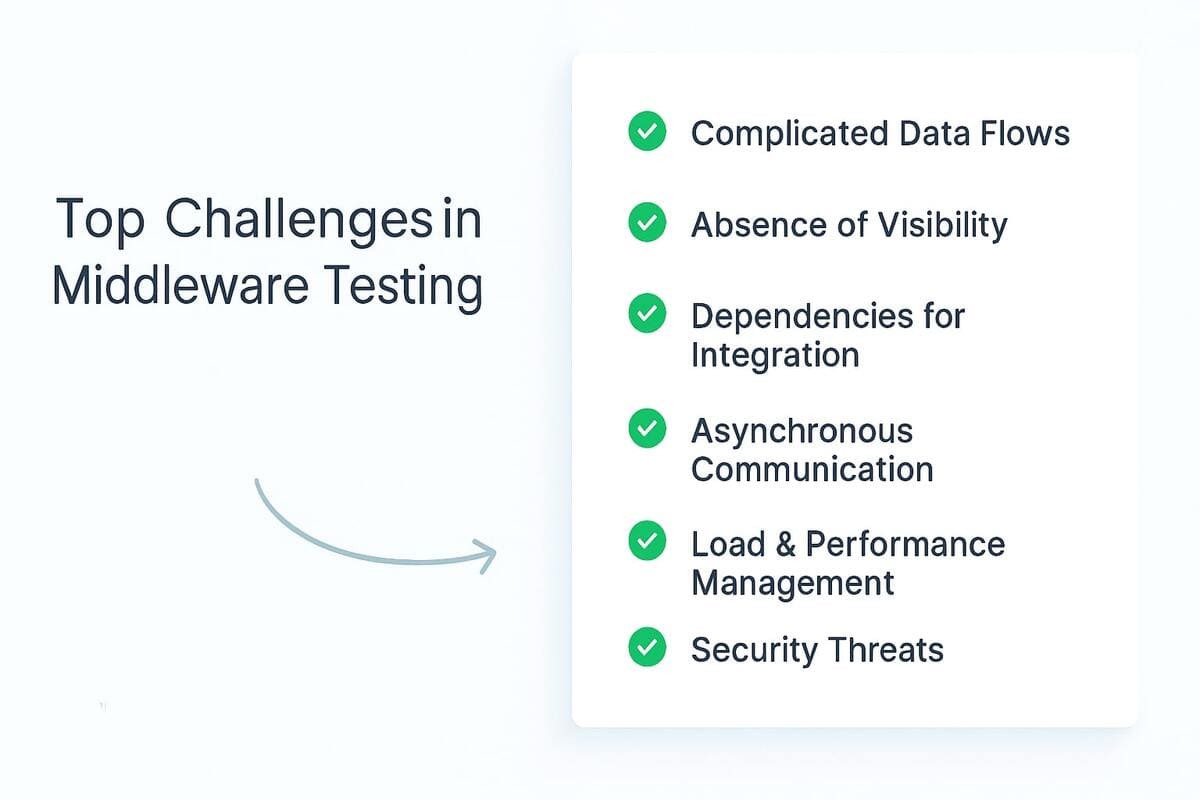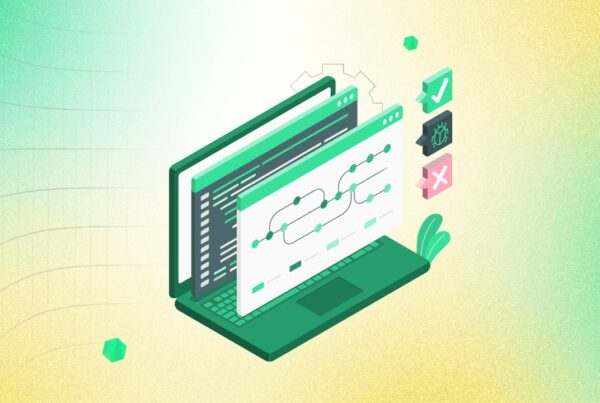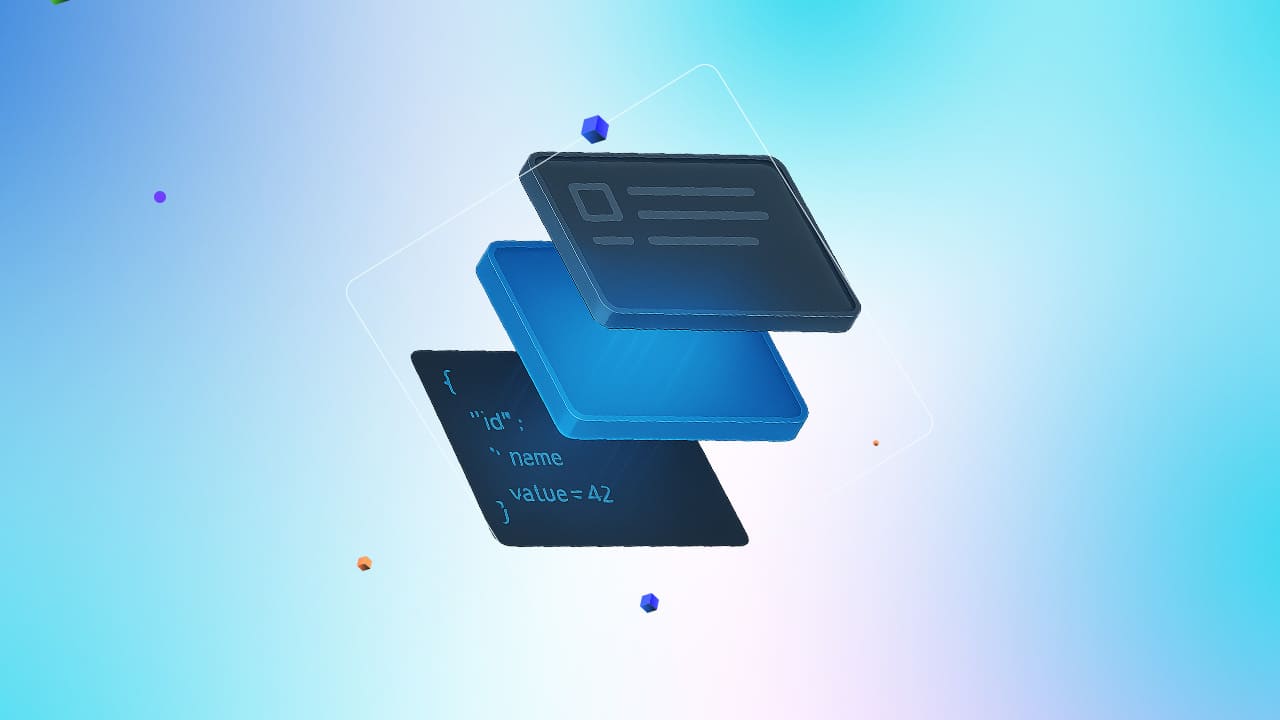Top Challenges in Middleware Testing (And How to Solve Them)

As modern applications become rapidly distributed and intricate, middleware integration is crucial in guaranteeing smooth communication between distinct systems and solutions. However, testing these middleware layers presents exclusive hurdles that vary significantly from old backend or User Interface testing.
From validating APIs and message queues to ensuring system interoperability & data consistency, the challenges in middleware testing are both architectural and technical. Missed bugs or defects in middleware can result in cascading failures, making robust testing helpful and essential.
What is Middleware Testing?
It focuses on validating the security, functionality, performance, and reliability of middleware elements that link different databases, services, and apps in a software architecture. Middleware acts as a communication layer that allows information flow and interaction between different systems, like messaging systems, app servers, and web servers. Unlike outdated back-end or front-end testing, middleware testing assesses components such as:
- APIs & web solutions
- ESBs (Enterprise service buses)
- Message queues (e.g., Kafka, RabbitMQ)
- Data transformation engines
- Authorization & authentication layers
This testing guarantees that all elements incorporated through middleware integration function cohesively, allowing seamless communication and decreasing data corruption or loss across the system.
Why is Middleware Testing Significant?
Middleware testing is crucial for the following reasons:
- Guarantees Smooth Integration: Middleware binds heterogeneous systems. Testing proves that these connections are firm, unfailing, and reliable under multiple situations.
- Verifies Business Logic Flow: Middleware often filters, routes, or changes data between systems. Any mistake here has the potential to distort logic & produce inaccurate outputs.
- Enhances Performance: In the early stage of the development cycle, load testing at the middleware level can discover bottlenecks in message processing or data transfer.
- Boosts Security: Middleware can manage authentication and sensitive data. Testing helps in finding glitches in these transit layers.
- Minimizes Downtime: Prompt identification of middleware problems avoids costly outages and cuts down on production debugging time.
Top Challenges in Middleware Testing
The following are a few of the most common middleware testing challenges:

1. Complicated Data Flows
Middleware occasionally changes data between multiple systems. Testing these flows for accuracy and consistency is a noteworthy challenge.
2. Absence of Visibility
One of the main middleware challenges is the absence of a UI (User Interface). As middleware does not generate direct output, QA engineers should depend on service calls, logs, and message queues to check behavior.
3. Dependencies for Integration
Middleware integrates with 3rd-party solutions, APIs, and legacy systems. These external dependencies might cause unforeseen failures or necessitate the test stubs and mocks to replicate.
4. Asynchronous Communication
Asynchronous messaging is used by many middleware systems (e.g., Kafka, RabbitMQ). Advanced tooling is needed to test for fault tolerance, delivery success, and message order.
5. Load & Performance Management
Large request volumes and data transformation tasks should be handled via middleware. Inadequate stress testing frequently results in the late discovery of performance bottlenecks.
6. Security Threats
What are the risks of middleware? Inadequately tested middleware might provide a security risk. If middleware incorrectly manages authentication, encryption or tokens, it can expose complex data or allow unauthorized access.
How to resolve these Middleware Testing Challenges?
Here are several tried-and-true methods to address these problems.
Employ Specialized Tools for Middleware Testing
To examine and check middleware functionality, use technologies that facilitate message validation, service virtualization, and API testing (its benefits).
Use E2E Integration Testing
Test across systems with real-world situations that mimic production environments. This aids in finding issues caused by mismatched protocols or service dependencies.
Examine Message Queues & Logs
Implement strong tracing and logging procedures to understand middleware behavior. This aids in identifying problems with data translation and debugging asynchronous workflows.
Mock External Services
Replicating third-party or unreliable services with mocks and stubs lowers test flakiness and enables consistent test execution.
Perform Stress & Load Tests
Use load testing tools such as Gatling or JMeter to replicate high-volume transactions & find performance glitches within the middleware layer.
Automate Security Scans
Incorporate security testing into the CI/CD process to reduce middleware risks. Early vulnerability detection is possible with tools like OWASP ZAP or bespoke test cases.
How ACCELQ Supports Middleware Testing?
Having the appropriate automation platform is crucial while dealing with the increasing challenges in middleware testing. ACCELQ stands out as a robust solution customized for testing integrated, complicated systems, including middleware layers.
Here are several ways that ACCELQ aids in overcoming middleware testing difficulties:
- No-code Automation: Both non-tech & technical experts can use the ACCELQ no-code platform, with a user-friendly interface, which enables teams to automate middleware flows without crafting complicated scripts.
- E2E Test Coverage: Middleware typically connects many systems, and ACCELQ facilitates smooth testing across databases, APIs, and user interface elements in a single flow.
- Service Virtualization: ACCELQ provides virtualization features to simulate external dependencies in situations where genuine services are unreliable or unavailable. This is crucial for handling integration-related middleware problems.
- CI/CD Integration: ACCELQ guarantees continuous and scalable middleware testing by connecting with well-known DevOps technologies, assisting teams in identifying integration problems early.
- Built-in Support for API & Backend Testing: ACCELQ’s native support for API testing greatly lowers effort and boosts dependability because middleware frequently exposes REST or SOAP APIs.
Whether it’s validating message brokers, testing data transformations, or simulating multi-system workflows, ACCELQ is equipped to handle the most critical challenges in middleware testing efficiently. You can streamline QA Automation with ACCELQ.
Real-world Examples or Use Cases
Banking Transactions Middleware
Communication between mobile apps and legacy core banking systems was managed by middleware from a top bank. Middleware testing uncovered asynchronous processing flaws in peak hours, which were fixed with performance alterations.
Healthcare Record Sync
A hospital network uses middleware to synchronize patient information between mobile applications and EMR systems. Testing guaranteed HIPAA-compliant data conversion and flagged security misconfigurations in the early phase of the deployment cycle.
Conclusion
Middleware is the backbone of advanced software ecosystems, facilitating smooth data transfer and systems integration. However, its complexity introduces several unique hurdles. From security risks and asynchronous communication to restricted visibility, the challenges in middleware testing can’t be overlooked.
Through the implementation of robust testing strategies, the utilization of tools like ACCELQ, and an emphasis on real-world systems, experts can effortlessly overcome these middleware challenges. As systems get bigger and integrations become more complex, middleware testing will only become more important, making it a critical part of any business QA approach.
Yuvarani Elankumaran
Technical Consultant at ACCELQ
Yuvarani Elankumaran is a highly skilled technical consultant at ACCELQ. With over a decade of experience in the field of Test Automation, Yuvarani is a seasoned professional who is well-versed in a variety of programming languages and automation frameworks.
You Might Also Like:
 Angular Testing Tutorial: What You Need and How to Start
Angular Testing Tutorial: What You Need and How to Start
Angular Testing Tutorial: What You Need and How to Start
 Test Case Design: A Guide for QA Engineers with Examples
Test Case Design: A Guide for QA Engineers with Examples
Test Case Design: A Guide for QA Engineers with Examples
 What is Automated Testing in Software Testing? A Beginner’s Guide
What is Automated Testing in Software Testing? A Beginner’s Guide
































